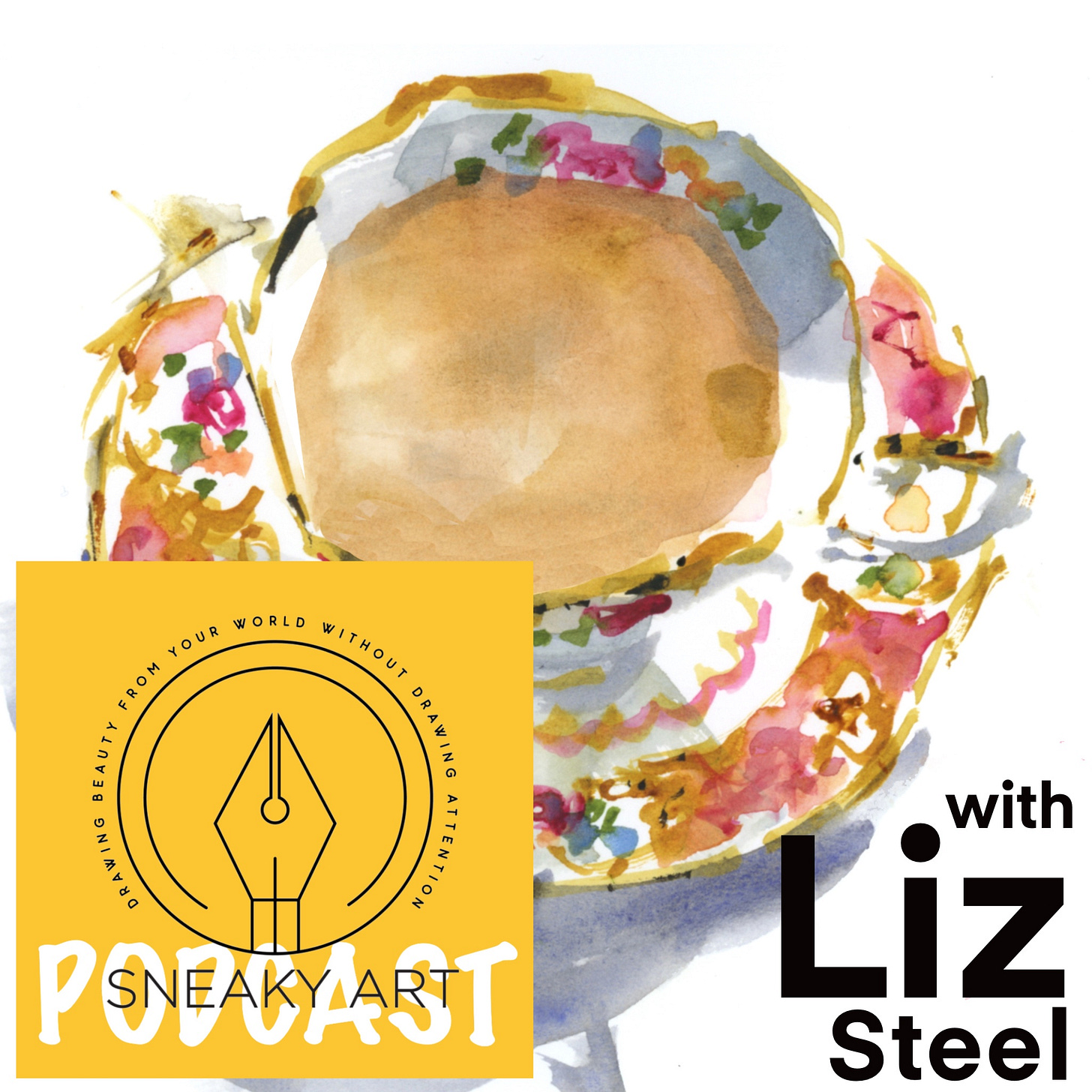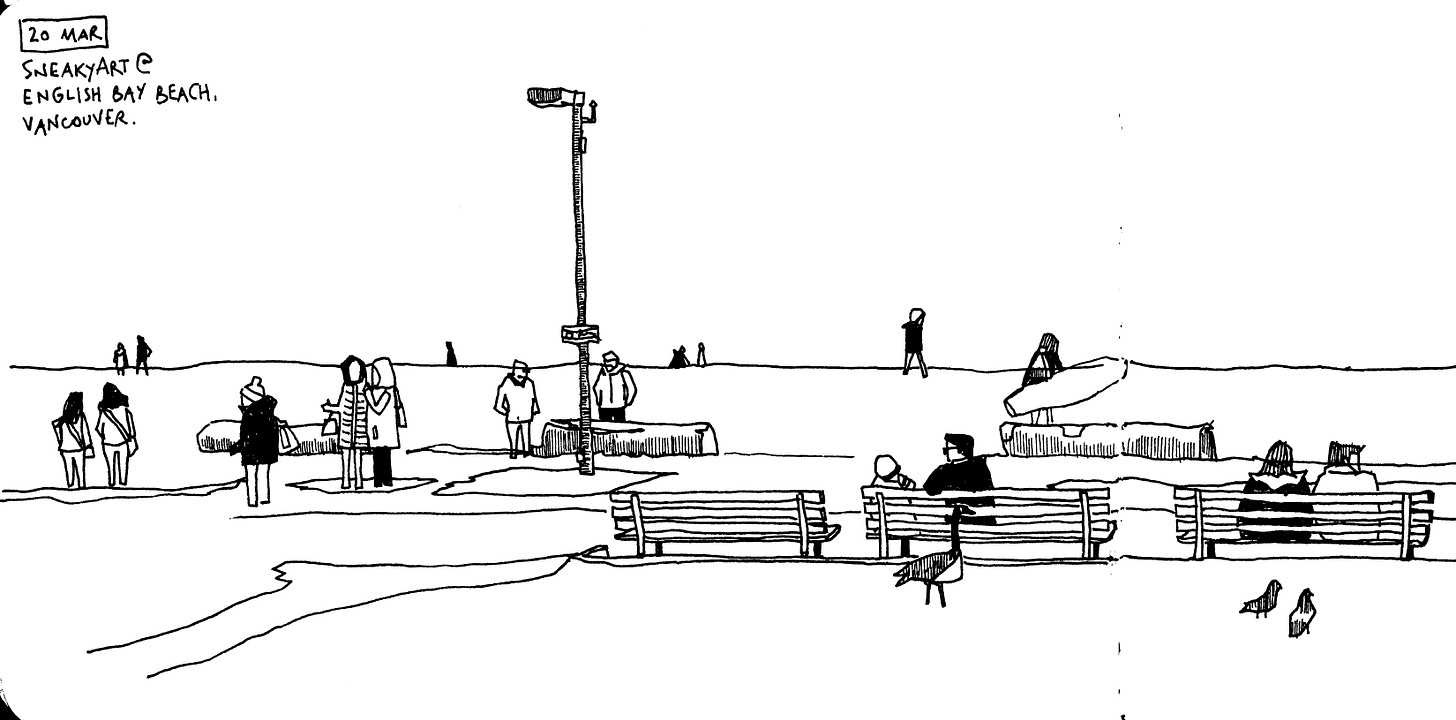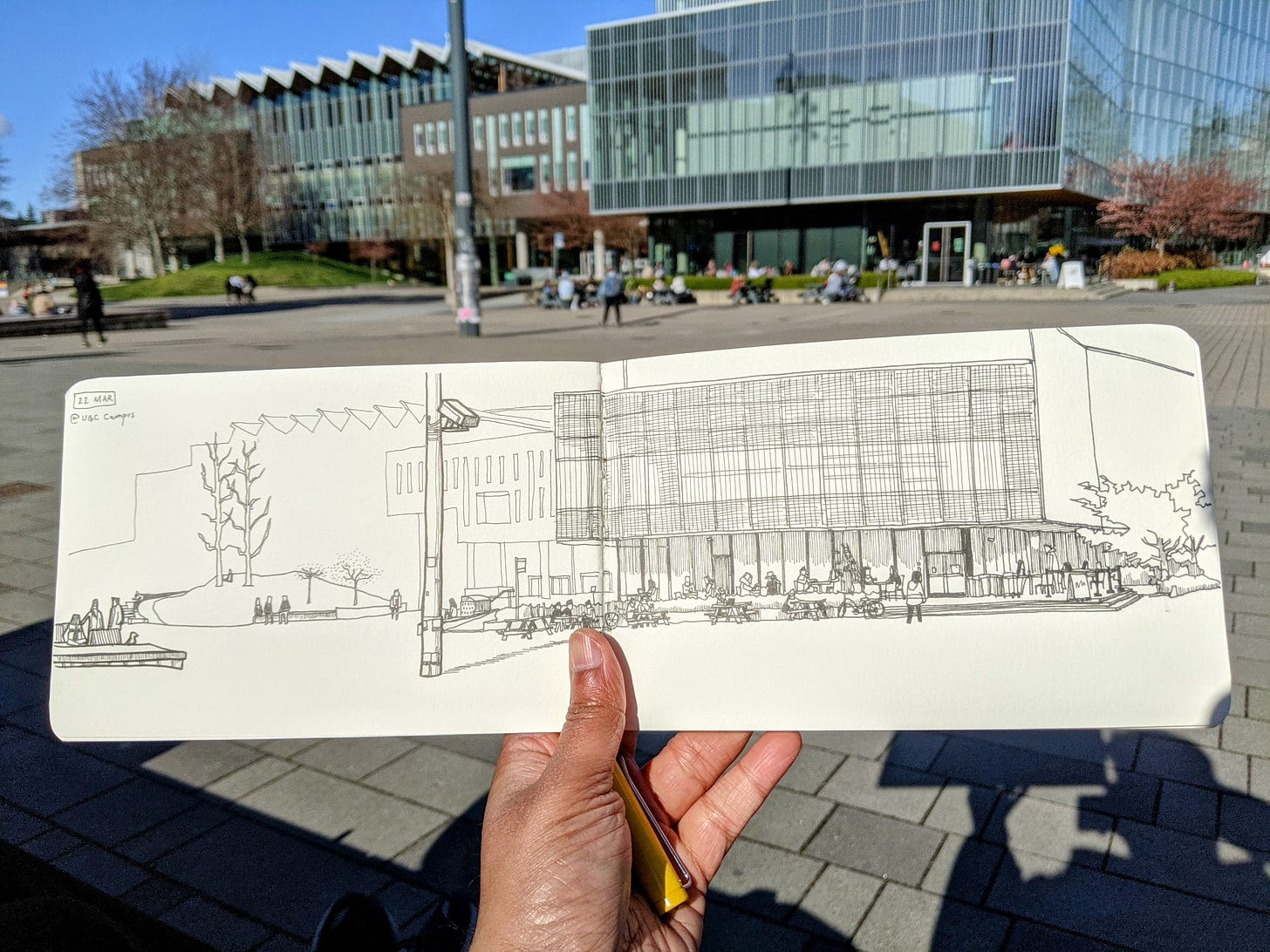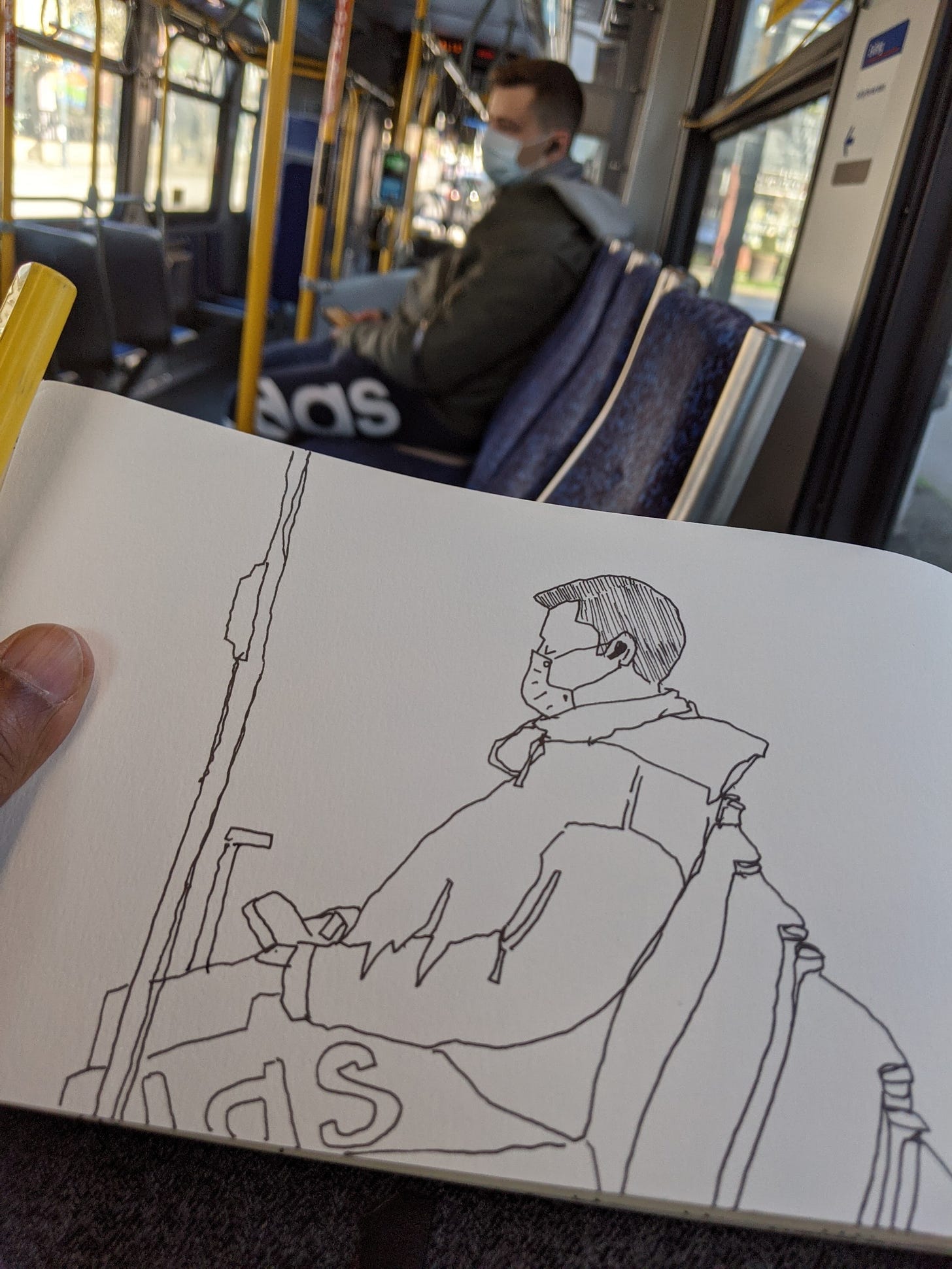#37 - Making it Look Easy
In this week’s newsletter, I am introducing a new episode of the podcast, with Sydney-based urban sketcher Liz Steel. Also, there are some recent sketches, and a new giveaway on my BuyMeACoffee page.
But first, a ramble about time…
I’m plodding my way through Carlo Rovelli’s Order of Time. It’s not a difficult book, I just read slowly. If you read it too, you’ll know what I mean when I say - I like to take my time.
Converting information into knowledge is a process of putting raw data through a system that examines it, picks it apart, and puts it back together. In reassembling the information, this system retains the things that are relevant and useful, and discards what it deems useless. I’m sure there are many ways to do this. For me, it involves sitting with some information, bouncing it off the walls of my mind, letting it mingle with other ideas and bits of knowledge, and playing with it in different, little ways while I go about my day. After some time, I revisit the information and see what it has become. It’s the way I’ve learned things my whole life - from the days of engineering college entrance exams in India, to post-graduate research at TU Delft. It’s how I’ve learned to draw, and also how I understand art.
Time, says Rovelli, is a construct of the human condition. It does not literally exist, and certainly not in the way we commonly understand it. His theories are interesting, and the parts that make sense to me are fascinating. But that doesn’t itself motivate me to read the book. Having reached the 40% mark, I turned away from it for a few days. Why was I reading about this? How does this kind of theoretical physics, or quantum physics, or loop gravity, matter to me? Does it play any role in my life? Is any of this information useful to me? Can I turn any of it into actionable, practical knowledge? Does it make my life better? I took my time with these thoughts. And after a few days, I was back to reading. The stuff here is important and relevant, my mind tells me, because our lives are ruled by time and in the ways we misinterpret it.
For the past few hundred years, increasingly so every few decades, our lives have been regimented by the ticking of clocks. Our very understanding of the purpose of life - how it should be lived, and therefore how it should not be lived - depends on the way we understand time. Not just in seconds or minutes or hours, but time in weeks, months, years, decades. It matters how we understand the passage of time over our entire lifetimes. How fast did I run today? Was I slower because I’m older? Have I become weaker? How quickly did I finish work today? Could I have done it in half the time? Am I falling behind? Did I answer all my emails on time? Is my hair greying? What does this mean for my health? How will others perceive me if it appears that I have lived in this world for longer than they have?
How did we mark the passage of time before we all got these ticking time-bombs in our pockets? Did the blacksmith keep time to the pounding of his hammer? Did the fisherman keep time with the lapping of the waves? Did the farmer count only days and seasons?
All understanding of time, Rovelli says, comes from our observation of things that change around us. There is no such thing as universal time, no steady ticking of a universal clock. There is only what we perceive, what we are able to perceive - and that is the interaction of life with other life, the changes sparked by things grinding against other things, changing forms from one to another, changing slowly or quickly, some appearing transient and others ethereal. What we call time is a product of the way we see our world, revolving around our sun, changing the seasons and creating and destroying all the things we know. Nothing is permanent, but we can see it within the brief moment of our existence as infinite. So if you sit by the sound of water, that sound can become your time, and I like to think that's why I like water bodies. In the face of certain oblivion, it is good to slow the world down, and watch things pass to a slower metronome.
Aane wala pal, jaane wala hai.
Ho sake toh is mein, zindagi bita do,
Pal jo yeh jaane wala hai.- Kishore Kumar (Golmaal, 1979)
(The future too will become the past / If you can, live your life inside this / Moment that will soon be gone.)
The sun is the same in a primitive way,
But you’re older.
Shorter of breath, and one day
Closer to death.- “Time”, Pink Floyd
Time also does this weird thing - it elongates and it compresses. The present is forever. The past is compressed. The future stretches into infinity.
The past is a selection of moments we remember, and others we strive to not forget. As more time passes, we remember even less. Studies show we superimpose new ideas and emotions into these old memories, just to give them new life. We reinterpret the past constantly, based on our current mood, or emotional dispensation, or new knowledge. Trauma can warp our memories too. In the struggle to hold onto certain memories, we let go of others. We not only forget the past, we forget that we have forgotten it. In a way, the past is lost to us immediately the moment it becomes the past. All that remains after that is a pale image warped and disfigured by the delusions of our minds.
The present is where we live. It does not change, because it cannot change. It is what it is. We are who we are. We cannot change in the present, because the present is timeless.
And then there is the future, another spectacular construction of the human mind. The future is infinite, and into that infinite space we procrastinate all our important tasks, dreams, and plans for what we call do with our lives once we have gotten past the present. In the future, anything is possible. Whatever we want, however desperately we want it, we can put it in the future. The mind bends our present reality to make that future look possible and attainable and rational - a fitter you, a happier you, a safer world, a cleaner environment, a completed to-do list, a fancy promotion, happiness, contentment, true joy.
I’m getting too metaphysical. There’s more to read, and more to understand. Maybe I’ll come back to it another day.
Ep 14 - Making it Look Easy with Liz Steel
In the latest episode, I speak with Sydney-based urban-sketcher Liz Steel about the ways she makes her art look effortless and spontaneous. Liz took a big leap of faith in her professional life - quitting a career in architecture to become a full-time artist and educator. What does she carry from her education and experience that informs her art today? How does she benefit from a regular blogging habit? And in what way is teaching useful to the artist keen on self-improvement?
Another point I was curious to pick with Liz was the point of view of an architect with a sketchbook, and the ways that it differs from a non-architect urban sketcher. We discuss how a knowledge base helps to better appreciate the history and evolution of art in all its forms, architecture included.
Whimsy is also a key part of Liz’s work, as you may see in her many paintings of tea-cups. I asked where that comes from, and the answer surprised me. It helped take our conversation to another depth, as we talked about the importance of repetition in an art practice. Simply put, repetition is key to deeper lessons and real progress, and genuine interest is the catalyst to successful (not boring) repetition.
Click below to catch links to the conversation and a summarized transcript.
New Member Giveaway
The process of editing a podcast episode involves listening to it 3-4 times. As a result, I inevitably have many more thoughts about the topics afterwards, which I was not able to share with the guest. With this episode onward, I am compiling those thoughts and reflections as an extra commentary provided for free to all supporters who buy me a coffee every month!
The giveaway will be emailed as a PDF download this weekend, with a more detailed transcript, extra commentary, and examples of Liz’s art that supplement our conversation. (The PDF is also available to non-members for a small fee.)
In SneakyArt this week…
… People by the water
A commenter on Facebook said this drawing reminded them of sheet music, and now I can’t un-see it. Different people at different lines represent musical notes at different pitches. The goose at the front is a bass note, as are the two pigeons. Far away is the high E note of a man walking alone, half-hidden behind the sand.
Read more about this drawing, the goose in question, and some notes about composition.
… The UBC campus
We went to check out the University of British Columbia campus and it is very beautiful. At the end of a long day of walking, we sat down with coffee to enjoy the view, and I made this drawing. So much of composition is affected by the ‘sketchbook frame’, both what we emphasize and what we discard. The frame decides everything.
… Bus #14
On the bus ride back home, I made a quick drawing of a fellow passenger lost in the reflections of his phone. Completed it just as he got off.
Next week, I will have some more things to say, and more SneakyArt. Thank you for your time and attention.





